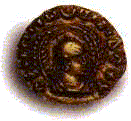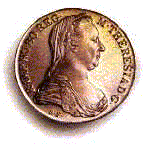Map of Eritrea
Location and geography
Eritrean history
Border conflict with Ethiopia
Political structure
Eritrean anthem
Economy & currency
Climate
People
Languages
Religion
Health care
Transport
Cuisine
News, links, books and more
Asmara (Asmera)
Agordat (Akordat)
Assab (Asseb)
Barentu
Dahlak islands
Dekemhare (Decemhare)
Ghinda (Ginda)
Keren (Cheren)
Massawa (Massauwa)
Mendefera (Adi Ugri)
Nakfa (Nacfa)
Semenawi Bahri (Filfil)
Tessenei
(Teseney)
by Jacky Sutton
In ancient history, an outstanding feature of trade between the Mediterranean countries and the Eritrean Sea was the use f money. Along the route from Adulis, the principal outlet to the sea of the ancient civilization to cities like Kohaito (Coloe), Keskesse, Metera (Belew Kelew) and others, archaeologists have uncovered coins from those days.
In the 3rd Century AD, coins of gold, silver and bronze were minted, with inscriptions in Greek and the indigenous Semitic language, Ge'ez. All sorts of physical items have, of course been used as money by different societies. In Denkalia, presently part of the Southern Red Sea administrative region, salt is still being used as money.
The coins bore the busts of kings and religious symbols of the sun and the crescent of the moon god Alemkah before Christianity; afterwards, the cross replaced the sun and moon. The new religion spread with the development of monasteries in the 6th and 7th centuries. The cross still appeared on the coins, which continue to be unearthed throughout the region, and even as far away as India
Until 1997, when the Nakfa (ERN) was introduced, the legal tender in Eritrea was the Ethiopian birr. You would have heard the described as a "kirshi", "riyal", "ghenzah", "soldi", "lira", "thaler" and even "dollar". The various names reflect the interwoven cultural influences of the area. Riyal is Arabic, as is kirshi (corrupted qirsh), whereas ghenzah is a Tigrinya word, also meaning property. When you thank someone, they will respond "Ghenzebka/ki" - literally "It is yours (your property)".
The Eritrean Nakfa is issued in notes with denominations of 100, 50, 10, five and one Nakfa. Coins are 100 cents, 50, 25, 10, five and one cent. The one-cent coin has so little purchasing power that you might find you are given five cents in change instead of six. You are no being cheated; it is just that the shopkeeper might not have any one-cent coins, or might feel that you would be insulted if the exact change were counted out to the nearest cent.
Soldi and lira are Italian words, thaler is Austrian and dollar is its American derivative. The silver thaler coin, embossed with the head of Empress Maria Theresa of Austria, has a fascinating history. The original coins were minted in 1780 in Austria, as that country's legal tender. But the empress died the same year and the instantly obsolete coins were sold to merchants on the Horn of Africa who wanted something less cumbersome for their commerce than the salt slabs they used as currency. The foreign coin, with the bust of the buxom empress visible in the then fashionable décolletage was a great success.
At the same time, during the 1890s, the Italians began introducing their own lire. The subsequent Fascist coins bearing Mussolini's face and jutting jaw were virtually ignored by the merchants.
After the British defeated the Italians in World War II and took over the administration of Eritrea, they realized how popular the Maria Theresa thaler was, and so they minted, in India, exact replicas of the old Austrian coin. These also proved so popular that the coins rapidly disappeared under mattresses or were hidden in dhows bound for Arabia. Strict controls were introduced, but the coins were horded as currency right up to the end of the 1950s. Today, you find them in curio shops. Paper money was never popular, for hoarded paper is vulnerable to fire, rain, rats and goats.
Now the first Eritrean currency, the Nakfa, has replaced the Ethiopian birr. It may seem strange, at a time when countries such as those of the European Union are trying to create or revive pan-national regional currencies, that Eritrea is devising a new one.
However, there are economic reasons why Eritrea took the important step of introducing its own currency. During the seven year common currency era, the Ethiopian monetary authorities conducted a monetary policy for the birr as a whole. Eritrea was in no position either to conduct its own monetary policy or to influence Ethiopian monetary policy. As the currency-issuing authority, the National Bank of Ethiopia was the sole beneficiary of the seigniorage that accrued as a result of monetary expansion. It was thus to respond to Eritrea's national interest that the national currency was introduced.
For the first time in its history, Eritrea has the authority to formulate and conduct its own monetary and foreign exchange policy. The bank of Eritrea, the country's central bank, has already established policies based on market principles. It has eliminated foreign exchange declaration requirements for visitors coming into and leaving Eritrea. Exporters are allowed full retention of their foreign exchange earnings. The fixed exchange-rate policy of the common currency era has been abandoned for a managed-float exchange-rate system. With the introduction of the Nakfa, Eritrea has entered a new era in its history.
from: Eritrea Horizons
The magazine of Eritrea's tourist industry
Vol 2 No 1


